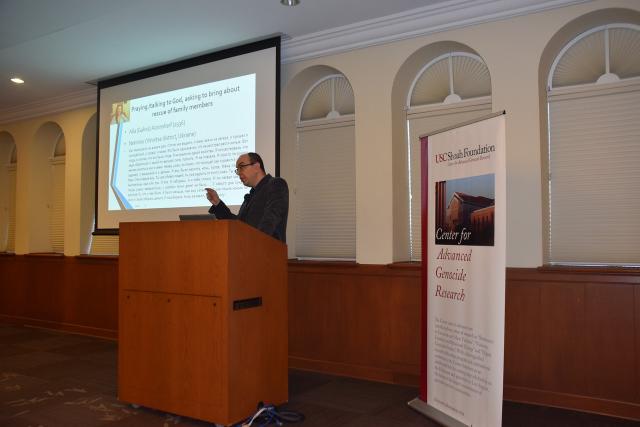“Religion and Jewish Survival in the Occupied Soviet Territories” Kiril Feferman Lecture (Summary)

Kiril Feferman, PhD, the 2015-2016 Center Fellow, gave a public lecture at the USC Shoah Foundation Center for Advanced Genocide Research focusing on the underresearched topic of the role of religion in influencing the behavior and decisions of Jews and non-Jews in the Nazi-occupied Soviet territories between 1941 and 1944.
Feferman began his remarks by emphasizing that while his current research focuses on survival, the survival rate in the Soviet territories was very low – around .2%. He explained that the USC Shoah Foundation Visual History Archive has been essential in preserving the memory of what happened in these territories during World War II. If the Shoah Foundation set out to collect testimonies about these territories now, Feferman argued, there would be nothing to be recorded since so many of the survivors from these regions have passed away.
Then he provided the audience with context about religion in the USSR. Beginning in the early 1920s, there was a crackdown on all religions, resulting in a considerable decrease in religious observance. During World War II, as Soviet occupation extended westward, the Soviets acquired populations in which people detested the communist atheist state. The Soviets found it impossible to suppress religion in the short time they had until the invasion by Nazi Germany. Under German occupation, there was a religious renaissance. Churches that had been closed were reopened, and people were encouraged to embrace religion again.
After providing this context, Feferman began to delineate the variety of Jewish responses in the occupied Soviet territories that were influenced by or involved religion:
– Jews praying for salvation
– Jews praying to precipitate the death of evil-doers
– Jews talking to God about the rescue of their family members
– Jews talking to God in trying to understand the incomprehensible
– Attitudes towards baptism
Feferman illustrated these with case studies from the USC Shoah Foundation Visual History Archive.
One powerful example Feferman shared regarding baptisms was from the testimony of Mikhail Bliumenblat. In his testimony, Bliumenblat talks about how in the Vinnitsa region of Ukraine the executions briefly stopped. The authorities gathered 300 Jews together in a square with a church. Bliumenblat stood near the church, being encouraged by the authorities to be baptized. He faced a choice of whether to embrace Christianity and be baptized. Bliumenblat tells the story of seeing a rabbi in the crowd. The rabbi said that he would convert for the sake of life, but that inside he would remain a Jew. Mikhail did not convert. Not long after, there were roundups in this area of Vinnitsa. Many of those who were baptized were rounded up and killed. So baptism had not saved their lives after all.
Feferman then moved on to analyze instances in testimonies in which Jews worked to preserve and protect their Judaism even in harsh and extreme circumstances.
In one Hebrew-language testimony by Kopel Kolpanitski, he shares his experiences in Sosny, Belorussia where teenagers from the same shtetl hid in the forest during a cold winter. The group searched for potatoes to eat. Normally they shared one potato between them, but they had three potatoes for their big meal before Yom Kippur. After sharing the potatoes, they began to fast in religious observance. Feferman argued that the preservation of religious identity and observance remained critical to them, even as they were starving, freezing, and fighting for survival.
The next topic he touched upon was the decisions of the local population – including priests and laypeople – that they sometimes explicitly related to religious motivations.
The priests’ responses included:
– Baptizing Jews for money
– Baptizing Jews for the sake of baptism
– Rescuing Jews because if the Jews were captured and tortured, they might reveal information that would bring about the priest’s arrest and execution
The religiously-motivated decisions that laymen or ordinary people made included:
– Encouraging Jews to preserve their faith (Feferman related one anecdote where the non-Jewish rescuer provided a Jew with a prayer book that the rescuer obtained from a nearby ghetto that had not been liquidated yet. The rescuer encouraged the Jew to continue to observe his religous practices.)
– Encouraging Jews to embrace Christianity (especially among Baptists) and then providing Jews with aid within their group.
– Trying to protect baptized Jews from the authorities because they are “ours.” This sometimes brought about clashes between authorities and local Christians.
In regions supposedly unaffected by religion, Feferman argued, religion motivated 10% of the rescuers. Religious motives resurfaced as a small minority of people went out of their way to help and rescue Jews
In the Q&A that followed Feferman’s remarks, an extensive discussion arose about the methodological challenges of the project, ranging from why he chooses to use the term “religion” to the interpretive license he takes in determining what choices by whom are motivated by religion and what choices are motivated by what he calls mundane or pragmatic considerations. The discussion further illuminated the incredible complexity in these regions. Feferman argued that examination of rescue and religion adds further layers to this complexity since while rescue is rarely examined in these areas, the role religion plays in rescue has received almost no attention until now.
To view his lecture, click here.